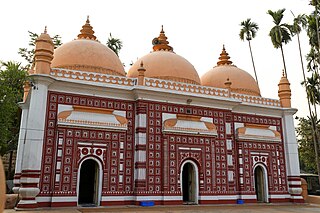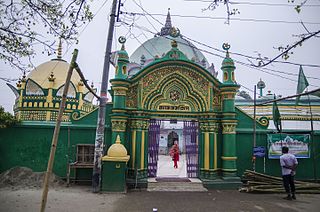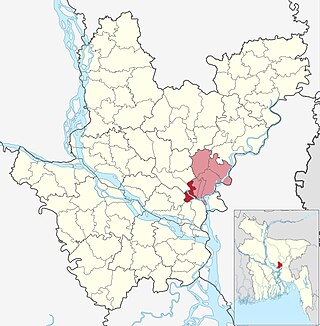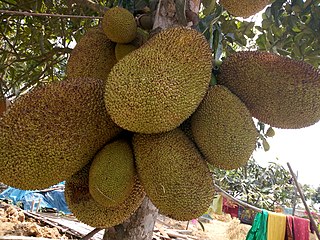
Education in Bangladesh is administered by the country's Ministry of Education. The Ministry of Primary and Mass Education implements policies for primary education and state-funded schools at a local level. Education in Bangladesh is compulsory for all citizens until the end of grade eight. Primary and Secondary education is funded by the state and free of charge in public schools.

Panchagarh is a district of the Rangpur division in Northern Bangladesh. Panchagarh is the northernmost district of Bangladesh. It lies between 26º00' and 26º38' north latitudes and between 88º19' and 88º49' east longitudes. It was established as a district on 1 February 1984.

Sirajganj District is a district in the North Bengal region of Bangladesh, located in the Rajshahi Division. It is the 25th largest district by area and 9th largest district by population in Bangladesh. It is known as the gateway to North Bengal.
Chakma is an Indo-Aryan language spoken by the Chakma and Daingnet people. The language has common features with other languages in the region like the Chittagonian, Tanchangya, Arakanese and others. It has 483,299 speakers in Bangladesh primarily the Chittagong Hill Tracts, and another 230,000 in India, including 97,000 in Mizoram, Tripura and Arunachal Pradesh. It is written using the Chakma script, but literacy in this script is low.

Gazipur Sadar is an upazila (sub-district) of the Gazipur District in central Bangladesh, part of the Dhaka Division.

Bhairab is a upazila of Kishoreganj District in the Division of Dhaka, Bangladesh. Olukanda was another name of Bhairab. The city centre of this upazila is Bhairab. About 118,992 people live in Bhairab municipality which makes this city the largest in Kishoreganj District and 28th largest city in Bangladesh.

Itna is an upazila of Kishoreganj District in the Division of Dhaka, Bangladesh. Itna Upazila is one of the largest upazilas in Bangladesh by area. The reason for its spread is the massive Haor area.

Narayanganj Sadar is an upazila of Narayanganj District in the Division of Dhaka, Bangladesh.

Gosairhat is an upazila of Shariatpur District in the Division of Dhaka, in south central Bangladesh.

Shariatpur Sadar is an upazila of Shariatpur District in the Division of Dhaka, Bangladesh. Shariatpur Thana was converted into an upazila in 1984. The upazila took its name from the district and the Bengali word sadar (headquarters). It is the subdistrict where the district headquarters, Shariatpur town, is located.

Birampur is an upazilla of Dinajpur District in the Division of Rangpur, Bangladesh. Birampur is an important city near India Border. This upazila is 256 km away from Capital Dhaka and nearly 56 km away from Dinajpur City. In spite of being far from Capital this north Bengal city is flourishing economically and culturally. A branch of the Jamuna River flows through Birampur Upazila.

Fulbari is an upazila of Dinajpur District in the Division of Rangpur Division, Bangladesh.

Patnitala is an Upazila of Naogaon District in the Division of Rajshahi, Bangladesh.

Ranisankail is an Upazila of Thakurgaon District in the Division of Rangpur, Bangladesh.
Motijheel is a central business district and a thana of Dhaka, Bangladesh. It is Dhaka's primary central business district, and also the nation's largest commercial and financial hub. Motijheel, located immediately adjacent to Dhaka's zero point, has the largest number of offices in Dhaka. Motijheel CBD also has one of the highest concentrations of high-rise buildings in Bangladesh. It has thus earned the title of the downtown and city centre of Dhaka and as the bankpara-officepara in Bengali.

Ramna is a thana (precinct) in central Dhaka and a historic colonial neighbourhood. Once the site of Mughal gardens, it developed into an institutional area during British rule in the late 19th century. It became a focal point for Dhaka's modernisation in the 1960s. It was the scene of many tumultuous events that ushered the independence of Bangladesh in 1971. Ramna Thana falls under the jurisdiction of Dhaka South City Corporation.
Hazaribagh is a Thana of Dhaka District in the Division of Dhaka, Bangladesh. Hazaribagh is part of Old Town, Dhaka, Bangladesh. 95% of Bangladesh's tanneries, which is where animal skins are processed to make leather, were located in or around Hazaribagh before they moved to Hemayatpur, Savar. In Hazaribagh, traditional establishments, culture, language and food can be found in daily life practices. Owing to its location near Buriganga River, Hazaribagh shares significant history as well. It is one of the most densely populated places on earth, though it is criticised for its low living standards.
Ministry of Education, abbreviated as MoE, is the ministry responsible for secondary, vocational and tertiary education in Bangladesh. Primary education and mass literacy is the responsibility of the Ministry of Primary and Mass Education (MOPME). The Ministry of Education contains two divisions:
Dakkhinkhan Adarsha Union Parishad was an union parishad of Dhaka Metropolitan North, Dhaka District, Dhaka, Bangladesh. It was bounded by Gazipur Sadar Upazila on the north, Khilkhet Thana on the south, Uttarkhan Thana on the east and Uttara and Shahjalal International Airport Thana on the west. Population 6,66,000 (Approximate). Average literacy 68.87%; male 73.57%, female 63.06%. The Union Parishad was dissolved in 2018 after its integration into Dhaka North City Corporation.
Khilkhet Thana is a thana (sub-district) of Dhaka, Bangladesh. It was created in 2005.














